Artificial deepening of seasonal waterholes in eastern Cambodia: impact on water retention and use by large ungulates and waterbirds
Thomas N.E. Gray 1, William J. McShea 2, Arnulf Koehncke 3, Prum Sovanna 4 & Mark Wright 5
1 WWF Greater Mekong, Conservation Strategy 3, House No. 39, Unit 05, Ban Saylom, Vientiane, Lao PDR
2 Conservation Ecology Center, Smithsonian Conservation Biology Institute, National Zoological Park, 1500 Remount Rd., Front Royal, VA 22630 USA
3,5 WWF Cambodia, #21, Street 322, Sangkat Beoung Keng Kang 1, Phnom Penh, Cambodia
3 WWF Germany, Reinhardtstr. 14, 10117 Berlin
3 Institute for Theoretical Biology, Humboldt-Universität zu Berlin, Invalidenstr. 43, 10115 Berlin, Germany
4 Department of Wildlife and Biodiversity, Forestry Administration, Ministry of Agriculture Forestry and Fisheries, 40 Norodom Blvd, Phnom Penh, Cambodia
1 Thomas.gray@wwfgreatermekong.org (corresponding author), 2 McSheaW@si.edu, 3 arnulf.koehncke@wwf.de,
4 prumsovanna@gmail.com, 5 mark.wright@wwf.panda.org
doi: http://dx.doi.org/10.11609/JoTT.o3935.7189-95
Editor: L.A.K. Singh, Bhubaneswar, Odisha, India. Date of publication: 26 May 2015 (online & print)
Manuscript details: Ms # o3935 | Received 04 February 2014 | Final received 02 March 2015 | Finally accepted 04 May 2015
Citation: Gray, T.N.E., W.J. McShea, A. Koehncke, P. Sovanna & M. Wright (2015). Artificial deepening of seasonal waterholes in eastern Cambodia: impact on water retention and use by large ungulates and waterbirds. Journal of Threatened Taxa 7(6): 7189–7195; http://dx.doi.org/10.11609/JoTT.o3935.7189-95
Copyright: © Gray et al. 2015. Creative Commons Attribution 4.0 International License. JoTT allows unrestricted use of this article in any medium, reproduction and distribution by providing adequate credit to the authors and the source of publication.
Funding: Conservation Force, and the Smithsonian Conservation Biology Institute; The German Academic Exchange Service (DAAD) and the German National Academic Foundation.
Competing interests: The authors declare no competing interests.
Author Details: Thomas Gray is regional species manager for WWF Greater Mekong and has been conducting conservation research in Cambodia since 2005. William ‘Bill’ McShea is an ecologist who has worked at the National Zoo’s facility in Front Royal, Virginia, since 1986. His research focuses on wildlife management and conservation of mammals and forests. Arnulf Koehncke was an intern supporting WWF Cambodia and currently works for WWF Germany, Prum Sovanna has worked in conservation for the government of Cambodia, and partner NGOs, since the mid 1990s and has led large mammal surveys across the country. Mark Wright was the landscape manager for WWF Cambodia’s Eastern Plains Landscape project.
Author Contribution: TNEG: designed the study, wrote the paper. WJM: designed the study, wrote the paper. AK: undertook fieldwork and data collection, wrote the paper. PS: undertook fieldwork and data collection. MW: designed the study, wrote the paper.
Acknowledgements: This study is part of the Eastern Plans Landscape project of WWF Cambodia and was funded by Conservation Force, and the Smithsonian Conservation Biology Institute. AK received additional support from the German Academic Exchange Service (DAAD) and the German National Academic Foundation through their joint Carlo-Schmid-Programme. Work in Mondulkiri Protected Forest is with the full support and permission of the Forestry Administration of the Ministry of Agriculture Forestry and Fisheries and we thank His Excellency Chheng Kim Soun, Song Keang, Keo Omaliss and Keo Sopheak for support. Lien Nor, Vann Sonny, Pin Chanrattana and Phan Channa assisted with field work.
Abstract: Natural seasonal waterholes (trapeang in Khmer) are an important feature of the deciduous dipterocarp forests of eastern Cambodia and are utilised by a number of globally threatened species of large ungulates and waterbirds. However at the end of the dry-season (April) only a small proportion of waterholes retain water. In 2011, we artificially deepened six waterholes in the core area of Mondulkiri Protected Forest, eastern Cambodia, removing 3m3 to 24m3 of earth (mean 16.5m3) from each. Surveys prior to deepening demonstrated that only one of these waterholes, and 10% of all waterholes surveyed in the study area (n=50), held water at the end of the dry-season. Following modification five of the six deepened waterholes (83%) held water at the end of the subsequent dry-season. From four camera traps over 448 trap-nights, 23 species including two globally threatened large ungulates, Banteng Bos javanicus and Eld’s Deer Rucervus eldii, and two Critically Endangered Ibises (Giant Thaumatibis gigantea and White-shouldered Ibis Pseudibis davisoni), were photographed foraging and drinking at the deepened waterholes between March and June 2012. Our results suggest that artificial deepening of natural waterholes does not cause damage, and makes these waterholes suitable for use throughout the dry-season. In the face of changing climate it is suggested that management plans should have a programme for the survey and determination of the status of waterholes every year and improve the use of water resources by artificial deepening.
Keywords: Climate change, conservation evidence, dry forest, Indochina, protected area management
.

INTRODUCTION
The deciduous dipterocarp forests of eastern Cambodia form part of the Lower Mekong Dry Forests Ecoregion and are globally significant for biodiversity conservation (Tordoff et al. 2005; Gray et al. 2012a). These forests support particularly important populations of large ungulates, including the largest global population of the Banteng Bos javanicus (Gray et al. 2012b) which is declared by IUCN Red List of Threatened Species as ‘Endangered A2cd+3cd+4cd’ from 2008 (Timmins et al. 2008), and large waterbirds including two species of Ibis which are listed as ‘Critically Endangered’ by the IUCN Red List of Threatened Species (Wright et al. 2012a).
Deciduous dipterocarp forests in the Eastern Plains Landscape are affected by strong monsoon creating a highly seasonal environment with long periods of water stress during the dry-season. The total annual precipitation is approx 1500–1800 mm, and the dry season lasts from November to April when less than 10% of annual precipitation is recorded (Bruce 2013). One of the key features of the deciduous dipterocarp landscape in the eastern plains is that the landscape is studded by natural seasonal waterholes (trapeang in Khmer). By the end of the dry-season (March–April) a majority of the waterholes in the landscape do not retain water (Koehncke 2010).
Waterholes that retain water throughout the dry-season are increasingly disturbed (WWF-Cambodia, internal data) as human activities across the landscape are on the increase, collection of non timber forest products is legally permitted, and there is illegal fishing and hunting of wildlife. This is considered detrimental to a number of threatened species including Eld’s Deer Rucervus eldii, which do not drink from other water-sources, e.g., pools in seasonal rivers, and Ibis for which waterholes are key foraging resources (Wright et al. 2012b, 2013). Predicted changes in precipitation and temperature associated with climate change are also likely to affect water retention during the dry-season in the landscape (Beaumont et al. 2011).
Artificial manipulation of water availability through modifying natural waterholes, or developing entirely new water sources, is widely used in tropical savannah and dry forest ecosystems for ungulate conservation (Owen-Smith 1996; Smit et al. 2007). However, attempts to modify natural waterholes in South-east Asian deciduous dipterocarp forest for conservation have not been documented previously. The aims of this study were to experimentally deepen waterholes in the core area of Mondulkiri Protected Forest, eastern Cambodia to examine, (1) whether deepened waterholes held water for longer periods during the dry-season than prior to modification and (2) whether artificially deepened waterholes could be used by globally threatened large ungulates and large waterbirds.
MATERIALS AND METHODS
Study Area
Mondulkiri Protected Forest (MPF) located in eastern Cambodia is approximately 2120km2, and forms part of the Eastern Plains Landscape, a protected area complex of over 13,000km2 including Yok Don National Park in Dak Lak province, Vietnam. The study area is largely flat and dominated by deciduous dipterocarp forest (Pin et al. 2013) with smaller patches of bamboo and riverine gallery forest. The study was conducted within approximately 450km2 inside the proposed core zone of MPF (approx. location 13005′N & 107030′E). This area supports the highest ungulate densities in the Eastern Plains Landscape, at approximately six individuals per km2, (Gray et al. 2013) and is the only area in MPF from which Eld’s Deer are regularly recorded. The study area, and modified waterholes, are all more than 30km away from the nearest village and not used at all by domestic ungulates. Based on remotely sensed imagery the total number of waterholes in the entire core area of MPF is 430 (WWF-Cambodia, internal data). Between January and April 2010 (mid to late dry-season) 50 waterholes within the study area were surveyed for water availability during three survey visits (Koehncke 2010; Fig. 1). These waterholes were a sub-set of the 64 waterhole within the study area.
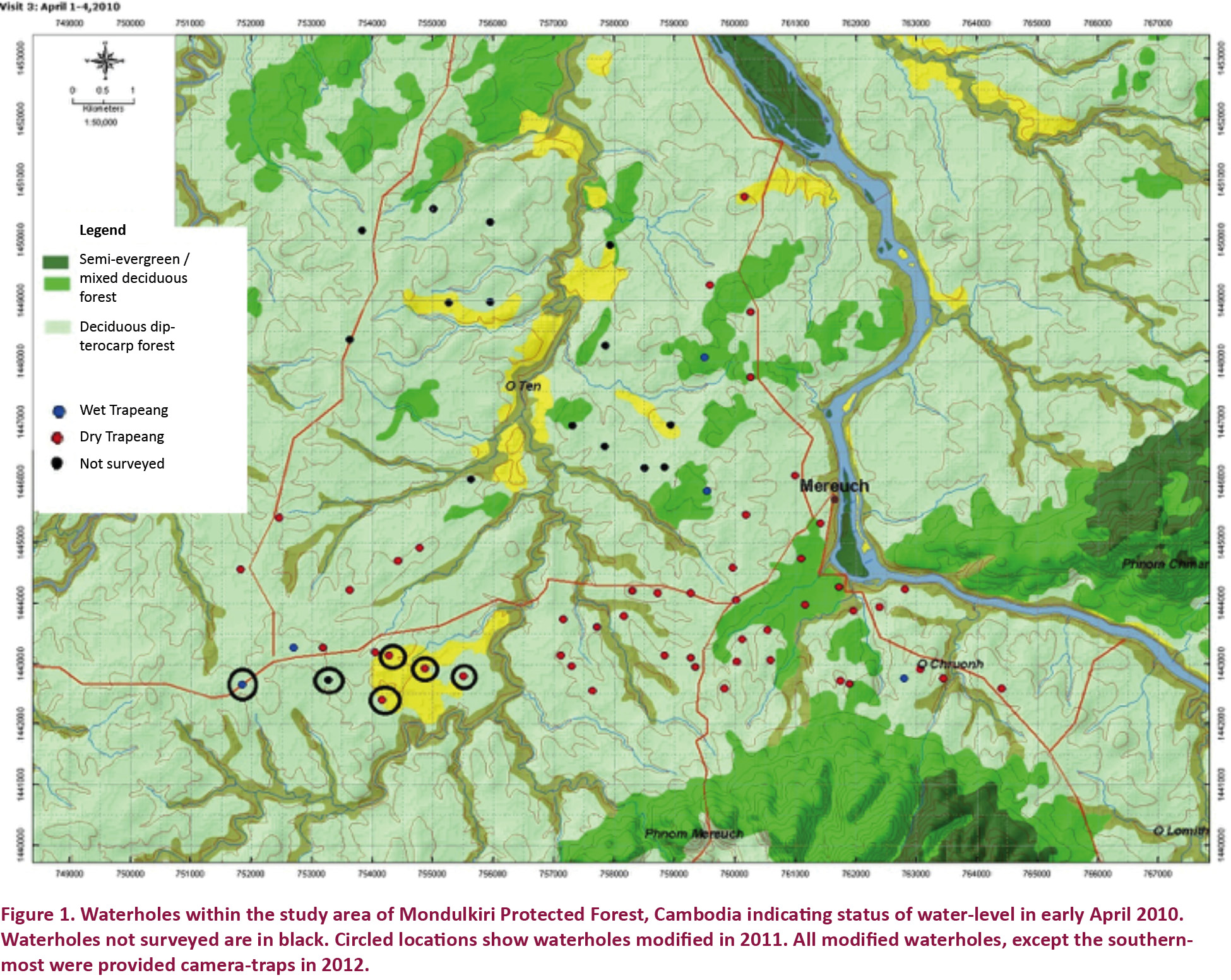
Waterhole manipulation
In April 2011 six totally dry natural waterholes (henceforth modified waterhole) in the study area were artificially deepened up to 100cm, from their centre (Image 1; Table 1). Extracted earth was moved to the edge of the modified waterhole and spread over an area 2–3 m from the modified waterhole ensuring that access for ungulates was not impacted. Deepening was done manually without the use of machines. Sub-contracted local villagers were engaged at a total cost of approximately 3,000 US$. The deepening work of each waterhole took approximately 2–3 days. Five modified waterholes were deepened by 50–100 cm with 16m3 to 24m3 (mean 19.2m3) of earth removed (Table 1). Due to a hard rock-like substrate forming the bottom of one of the modified waterhole #6 it was deepened by only approximately 20cm with a total of 3m3 earth removed (Table 1).
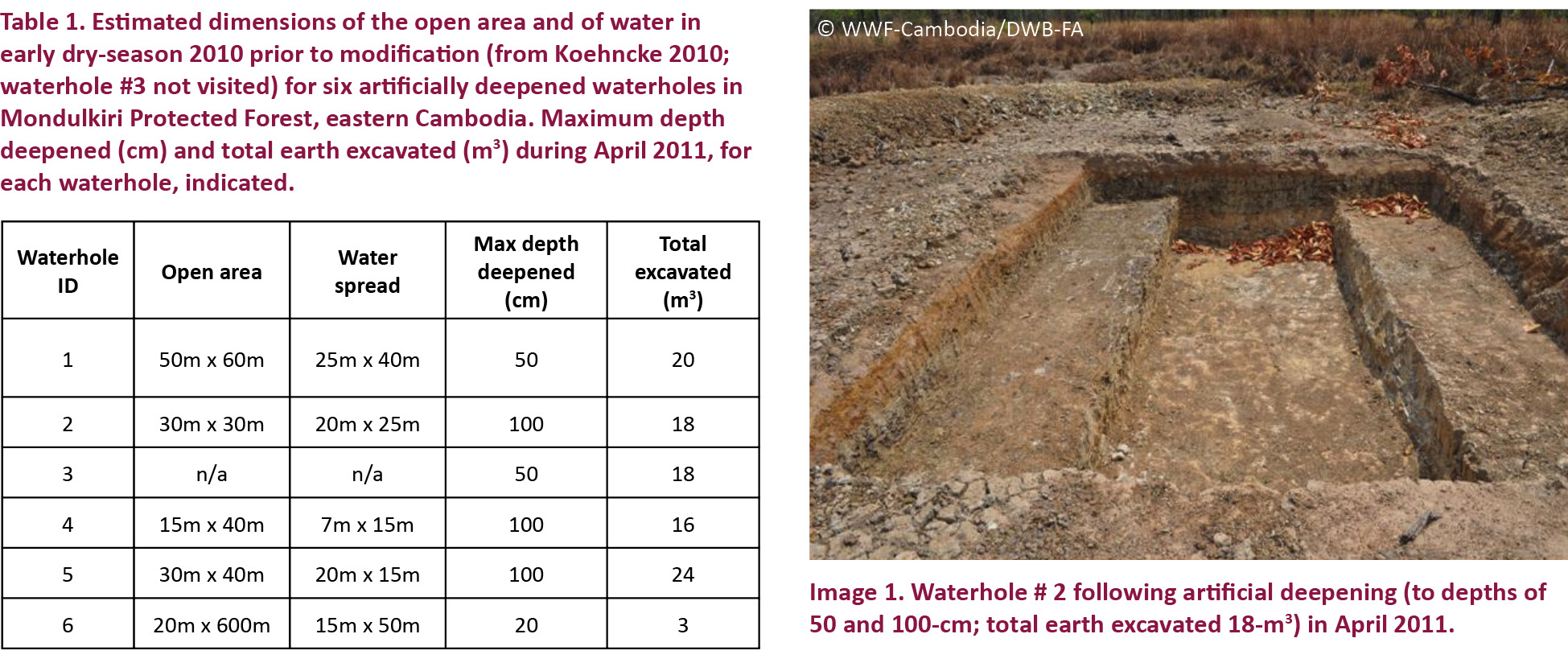
Monitoring use by ungulates and large waterbirds
Between March and June 2012 (late dry-season to early wet-season) automatic camera-traps (Reconyx RapidFire Professional PC90; Reconyx) were placed at each of the modified waterholes to photograph animals using the waterholes. The camera-trap at waterhole # 4 malfunctioned without producing any data. Although a robust study was not designed, the exercise could provide data from the remaining five modified waterholes. Records for a total of 448 camera-trap nights, with a range of 86–92 nights per waterhole were collected.
RESULTS
Patterns of water retention prior to modification
In late January 2010, 43 (86%) out of 50 waterholes held water. The number declined to five (10%) in early April 2010. The 50 waterholes surveyed in 2010 included five of the waterholes modified later in 2011. Four of these held water in early March, but only one (#6) in April.
Patterns of water retention following modification
Five of the six modified (i.e., 83%) waterholes retained water in April 2012 (i.e., post-modification). At the same time of the year in 2010, i.e., before modification, only one of these waterholes (20%), and 10% of all waterholes surveyed (n=50) had retained water. On 14 March 2012 all six of the modified waterholes contained water; on the 27 April 2012 five of the modified waterholes contained water with only waterhole (#6) dry. Assuming that the pattern of water retention in the unmodified waterholes across the study area were the same as during the 2010 surveys the manipulation of waterholes doubled the amount of waterholes holding water within the study area at the height of the 2012 dry-season
Use of modified waterholes by large mammals and waterbirds
Following the definition for ‘independent encounter’ by Phan et al. (2010), a total of 242 ‘independent’ camera-trap photographs of 23 species, including 10 globally threatened species, were obtained from five waterholes under study (Table 2 and 3; Images 2,3). The species included Banteng from all five waterholes and Eld’s Deer from three. Six species of large waterbirds—three stork, two ibis, and Sarus Crane, were photographed foraging within the modified waterholes (Table 2). Giant Ibis was recorded from all five modified waterholes and White-shouldered Ibis from three (Image 4).
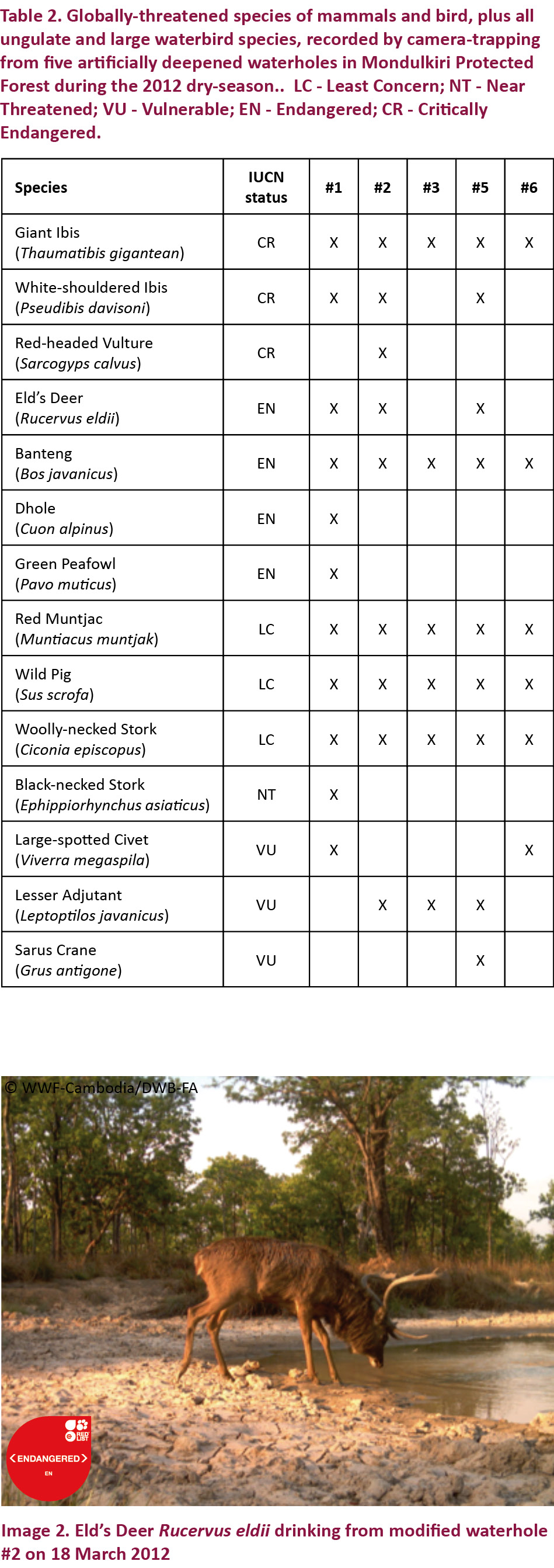
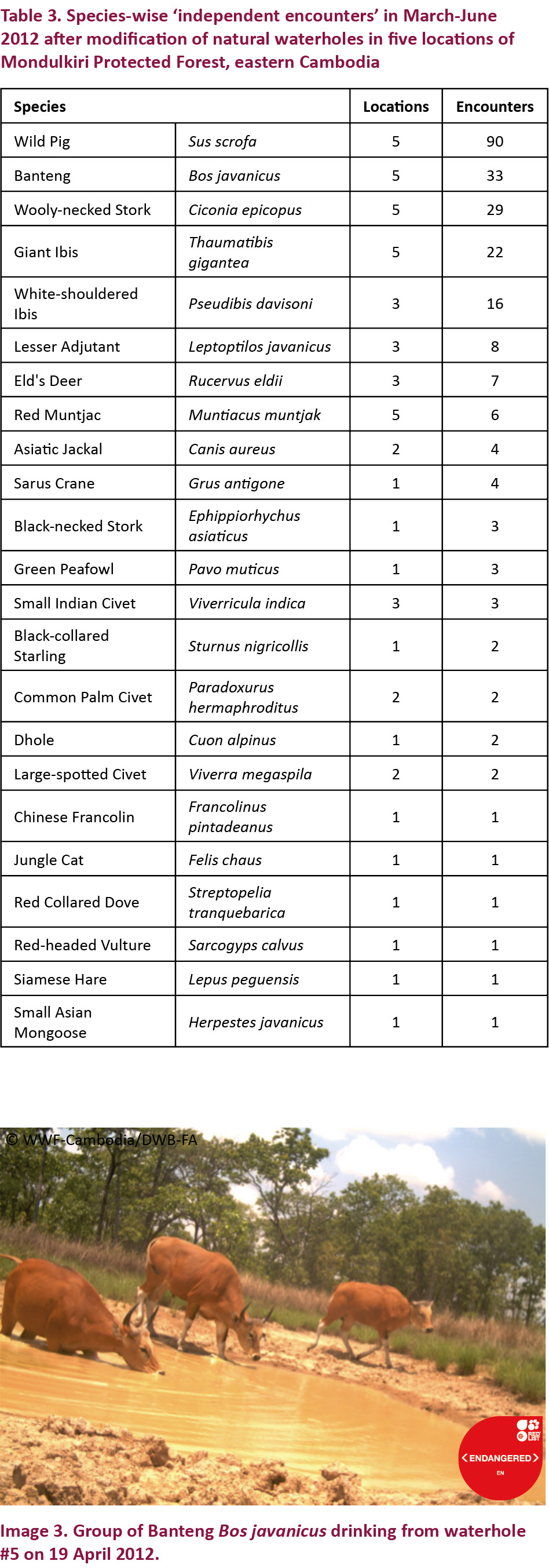
DISCUSSION AND CONCLUSIONS
Manipulation of water availability for rendering benefit to target species is one of the relatively common and direct conservation management actions in protected areas in southern Africa and Europe, but it is rare in Indochina (Owen-Smith 1996; Lacasa et al. 2010; Shrader et al. 2010). Instead, a number of temporary and innovative methods are practiced in protected areas in tropical Asia to overcome periods of water stress, but quantitative data showing their efficacy is limited or not accessible. Active provision of additional water into waterholes in South-east Asia may be unsustainable and logistically difficult.
Whilst it is unclear about the extent to which water limitation impacts survivorship and reproduction of threatened ungulates within Cambodian dry forest, it would be logical to conclude that water is a limiting factor and increased water availability could improve ungulate productivity. Radio-collaring of Eld’s Deer in a similar forest in Myanmar suggested movements and home-ranges were larger in the dry-season and this is likely to be related to reduced water availability (Mint et al. 2001).
The results of the present study form a record for reference and refinement of ways in which waterholes can be artificially modified to retain water for longer periods in the dry season in future. The simple technique we used increased water retention post-manipulation, and modified waterholes were used by a suite of threatened species characteristic of the Lower Mekong Dry Forests Ecoregion. It also proved that the practice can be continued to other waterholes.
We do not believe that modification of waterholes to enhance water retention is likely to increase chances of disease transmission between animals. In effect, it may, through increasing availability of water during the dry-season across more waterholes, prevent high densities of animals concentrated in few places.
The extent to which additional precautions prior to deepening waterholes are required is unclear. Ideally detailed geological studies to assess water retention ability below certain depths of excavation would have to be conducted. However the levels of expertise for such studies is likely outside both the technical, and financial, capacity of most protected area managers in Indochina.
Several unfounded apprehensions appear to have prevented artificial deepening of natural waterholes in the past. However, our results have clearly shown that the method we employed does not prevent use of waterholes by threatened (Table 2) and non-threatened (Table 3) species of large ungulates and waterbirds. Camera-trap photographs clearly show both ibis and storks foraging (Imgae 4) and Eld’s Deer and Banteng drinking (Images 2 & 3) at modified waterholes. When enhancing water availability within protected areas it is important that law enforcement and patrolling activities are focused to ensure modified water features are not targeted for illegal hunting or disturbance. Camera-trapping at the modified waterholes did not record any local people but unaccompanied domestic dogs were recorded from one waterhole on one occasion.
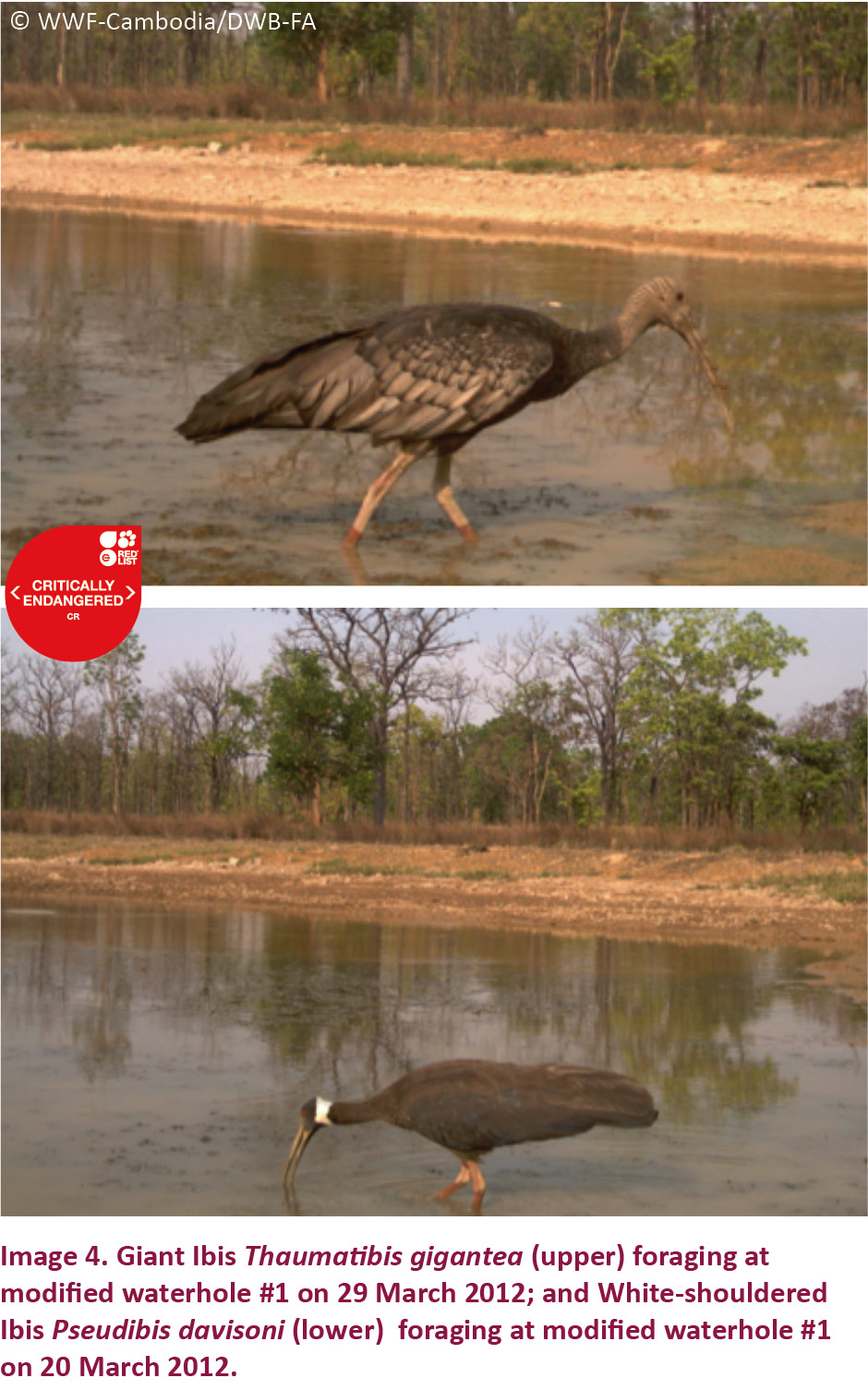
Whilst our results suggest that artificial deepening of natural waterholes is an effective technique for increasing dry-season water availability in highly seasonal deciduous dipterocarp forests, we recommend a number of future research activities into the process and ecological impacts of artificially deepening waterholes. Studies are required to assess the degree to which water availability is limiting for focal species in deciduous dipterocarp forests thus clarifying the extent to which waterhole manipulation is necessary. Recent studies have also suggested that dried substrates surrounding waterholes are an important breeding season resource for the Critically Endangered White-shouldered Ibis and thus retaining water throughout the dry-season in a majority of waterholes may be detrimental for this species (Wright et al. 2013). Studies are needed to compare large waterbird food resources between modified and unmodified waterholes across both dry and wet-seasons. The impacts of anthropogenic climate change on Indochina’s lowland deciduous forests are not yet clearly understood, but altered rainfall and evaporation will probably affect waterhole hydrology especially during the dry-season when water stress is already high (Timmins 2011). Modeling has also demonstrated that water stress may negatively impact ungulate populations particularly those which are sedentary and largely grazers, i.e., Banteng and Eld’s Deer (Duncan et al. 2012). Given that we have demonstrated the value of artificially manipulating waterholes for increasing water availability for large ungulates and waterbirds, our technique may be particularly valuable throughout South-east Asian deciduous dipterocarp forests in the face of a changing climate.
REFERENCES
Beaumont, L.J., A. Pitman, S. Perkins, N.E. Zimmermann, N.G. Yoccoz & W. Thuiller (2011). Impacts of climate change on the world’s most exceptional ecoregions. Proceedings of the National Academy of Sciences 108: 2306–2311.
Bruce, C. (2013). Creating options for long-term resource use and conservation in the eastern plains dry forest landscape of Cambodia, pp. 145–156. In: Sunderland, T.C.H., J. Sayer & M.H. Hoang (eds.). Evidence-based Conservation: Lessons from the Lower Mekong. Earthscan from Routledge.
Duncan, C., A.L.M. Chauvenet, L.M. McRae & N. Pettorelli (2012). Predicting the future impact of droughts on ungulate populations in arid and semi-arid environments. PLOS ONE 7(12): e51490; http://dx.doi.org/10.1371/journal.pone.0051490
Gray, T.N.E., R. Ou, K. Huy, C. Pin & A.L. Maxwell (2012a). The status of large mammals in eastern Cambodia: a review of camera-trapping data 1999–2007. Cambodian Journal of Natural History 2012: 42–55.
Gray, T.N.E., S. Prum, C. Pin & C. Phan (2012b). Distance sampling reveals Cambodia’s Eastern Plains Landscape supports largest global population of the endangered Banteng Bos javanicus. Oryx 46: 563–566.
Gray, T.N.E., C. Phan, C. Pin & S. Prum (2013). Establishing a monitoring baseline for threatened large ungulates in eastern Cambodia. Wildlife Biology 18: 406–413.
Koehncke, A. (2010). Report on Monitoring Waterhole-Dynamics in Mondulkiri Protected Forest. WWF-Cambodia, Phnom Penh, Cambodia, 32pp.
Lacasa, V.R.G., C.S. Garcia-Abad, R.P. Martin, D.J. Bartolome Rodriguez, J.A.P. Garrido & M.E.A. de La Varga (2010). Small game water troughs in a Spanish agrarian pseudo steppe: visits and water site choice by wild fauna. European Journal of Wildlife Research 56: 591–599.
Mint, A., W.J. McShea, S. Htung, A. Than, T.M. Soe, S. Monfort & C. Wemmer (2001). Ecology and social organization of a tropical deer. Journal of Mammalogy 82: 836–847.
Owen-Smith, N. (1996). Ecological guidelines for waterpoints in extensive protected areas. South African Journal of Wildlife Research 26: 107–112
Phan, C., S. Prum & T.N.E. Gray (2010). Recent camera-trap records of globally threatened species from the Eastern Plains Landscape, Cambodia. Cambodian Journal of Natural History 2010: 89–93.
Pin, C., C. Phan, S. Prum & T.N.E. Gray (2013). Structure and composition of deciduous dipterocarp forest in the Eastern Plains Landscape, Cambodia. Cambodian Journal of Natural History 2013: 27–34.
Shrader, A.M., S.L. Pimm & R.J. van Aarde (2010). Elephant survival, rainfall and the confounding effects of water provision and fences. Biodiversity & Conservation 19: 2235–2245.
Smit, I.P.J., C.C. Grant & B.J. Devereux (2007). Do artificial waterholes influence the way herbivores use the landscape? Herbivore distribution patterns around rivers and artificial surface water sources in a large African Savanna Park. Biological Conservation 136: 85–99.
Timmins, R.J. (2011). An assessment of the ‘vulnerability’ of the proposed Western Siem Pang Protected Forest to climate change, with recommendations for adaptation and monitoring. BirdLife International, Phnom Penh, Cambodia, 132pp.
Timmins, R.J., J.W. Duckworth, S. Hedges, R. Steinmetz & A. Pattanavibool (2008). Bos javanicus. The IUCN Red List of Threatened Species. Version 2014.3. www.iucnredlist.org, Downloaded on 28 March 2015.
Tordoff, A.W., R.J. Timmins, A. Maxwell, K. Huy, V. Lic & E.H. Khou (2005). Biological Assessment of the Lower Mekong Dry Forests Ecoregion. WWF Greater Mekong. Phnom Penh, Cambodia, 304pp.
Wright, H.L., N.J. Collar, I.R. Lake, N. Net, V. Rours, K. Sok, P. Sun & P.M. Dolman (2012a). First census of the White-shouldered Ibis Pseudibis davisoni reveals roost-site mismatch with Cambodia’s protected areas. Oryx 46: 236–239.
Wright, H.L., N.J. Collar, I.R. Lake, V. Bou & P.M. Dolman (2012b). Foraging ecology of sympatric White-shouldered Ibis Pseudibis davisoni and Giant Ibis Thaumatibis gigantea in northern Cambodia. Forktail 28: 93–100.
Wright, H.L., N.J. Collar, I.R. Lake & P.M. Dolman (2013). Amphibian concentrations in dessicating mud may determine the breeding season of the White-shouldered Ibis Pseudibis davisoni. Auk 130: 774–783.